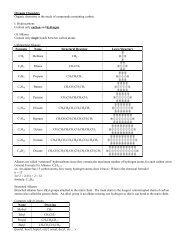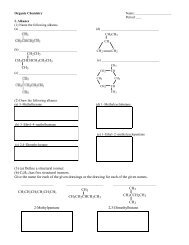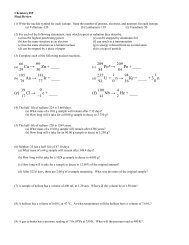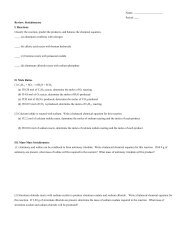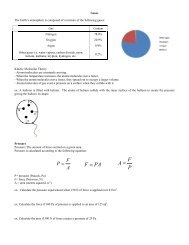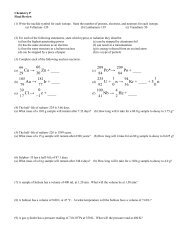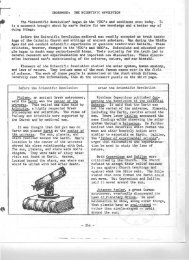- First of all, the 1950s were (for most) an era of unprecedented prosperity and expansion. More specifically: The Postwar Economic Boom: Increasing output & increasing demand – it really was thatsimple. Economist Galbraith called it the “affluent society” – productivity increased, peoplewanted more stuff, and they used consumer credit to keep buying, which caused profits (andpaychecks) to go up, spurring more consumerism, and so on. Per capita real in<strong>com</strong>e (adjustedfor inflation) jumped up, as did standard of living (for most). The Baby Boom: The baby boom was actually both a cause and effect of the new prosperity,as the new population generated new needs for services, esp. in the three industries thatexpanded most – construction, cars, and defense (well maybe not that). Housing & Highway Boom: The GI mortgages and Federal Housing Administration insuranceled to an explosion in home building and buying – prefabricated suburbia. Tons of newhighways were built, which also speed up the process of suburbanization. Military Spending: The other big reason for the economic boom was military spending, whichalso helped advance the electronics industry. Consolidation & Conglomerate Mergers: Due to the new technologies, industry ownershipbecame increasingly concentrated as only the big <strong>com</strong>panies had the $ to buy the new stuff.Conglomerate mergers (when unrelated industries join together to stabilize markets) becameincreasingly <strong>com</strong>mon. Even agriculture became dominated by big, mechanized farm<strong>com</strong>panies – no more family farms, fewer tenant farmers. Labor Merger: Finally the AFL and CIO joined back up again, but union membership still didn’tincrease all that much, probably b/c most workers were doing quite well. Environmental Costs – We screwed up the environment by dumping waste everywhere andspraying DDT (Rachel Carson, Silent Spring). We also wasted a lot of stuff. Sound familiar?- As for 1950s culture, here are some of the main themes: Conformity: The rat-race, status seeking suburbia, materialism…basically the same assuburbia now only people had strange looking black & white TV sets. Education: Education was a big concern, and many GIs went to college w/the provisions of theGI Bill of Rights. Parents also became obsessed w/their kids as successful students (wewouldn’t know anything about that, would we) and joined the PTA and so on. Education alsobecame a nat’l security deal with the Sputnik thing (“their scientists are beating our scientists”)so the NDEA was passed to enrich high school programs. Religion: Religion was seen as very <strong>Am</strong>erican – in 1954 they added that little “under God”phrase to the Pledge. Television: Evangelists and car salesmen had a new way to be heard, and heard they were asfamilies spend their time glued in front of the “idiot box.” Oh well. Women’s Roles: There was a cult of motherhood on one side, but the growing trend of womenin the labor force on the other. Youth Subculture: Music (oh dear – Elvis!) and movies like Rebel Without A Cause catered tobored teenagers dissatisfied with blah middle class conformity. Beat Generation: On the sidelines, a few serious artists tried to speak about <strong>Am</strong>erica’sproblems. The Beats (Allen Ginsberg, etc.) rejected conformity and embraced sexuality anddrugs – they were largely ignored in the 1950s but then were rediscovered in the 1960s.- The general prosperity notwithstanding, there was a large group of other <strong>Am</strong>ericans – immigrants, blacks,inner city dwellers, rural poor, Native <strong>Am</strong>ericans – that remained unaffected by the outburst of new productsand stayed very poor. But they were largely ignored.The [Early] Cold War (1945 – 1961)*General Origins of the Cold War*- Following the war, the US & USSR developed a tremendous rivalry. This was for several reasons… Power Vacuum – Following the collapse of Germany and Japan and the devastation of muchof Europe, there was the question of how rebuilding would <strong>com</strong>mence, and who would havehegemony in the areas where the Axis once dominated. Decolonization – Another source of instability was the disintegration of the big empires and thecreation of the new “Third World” countries, which both the US and USSR hoped to win overas military bases and markets. Failure of Diplomacy – Diplomacy was largely ignored b/c both countries were thoroughlyconvinced they were <strong>com</strong>pletely right, and weren’t willing to accept “appeasement.” US Economic/Strategic Needs – The US knew that its economic well being depended onexports, and therefore wanted to continue the trend towards economic expansionism through72
an active foreign policy. Also, the increasingly interconnected world (faster travel, etc.) madethe US feel it was important to establish defense away from home.Truman’s Tough Style – Truman was not a good diplomat.US Suspicion of Soviet Intentions – Throughout the Cold War the US obsessed over what theUSSR could and wanted to do. They really weren’t as much of a menace as we thought, butwe still were concerned they could take over our interests in Western Europe.- Basically, only US influence was allowed, so as soon as the USSR started taking interest in new territorywe lost it…*The Cold War under Truman*- After the war ended, the US & USSR lost no time in getting each other mad. As follows: Soviet Expansion: In 1945 The USSR didn’t allow the Polish gov’t that had been in exile inLondon to join their new <strong>com</strong>munist gov’t in Lublin (as they had promised). They also took overRomania, and encouraged coups in Hungary (1947) and Czechoslovakia (1948). The Sovietsclaimed the US was doing the same thing, and <strong>com</strong>plained about the double standard. Atomic Diplomacy: The USSR whined that the US was trying to scare them into concessionsb/c of their monopoly on the atomic bomb. Then Truman refused to turn the bomb over to aninternat’l institution and backed the Baruch Plan instead – the US would give up its atomicmonopoly if all the world’s fissionable materials were given to an agency. The Soviets felt thiswould let the US continue researching the bomb w/o letting anyone else… World Bank/IMF: After clashing on several fronts (reconstruction loans, Iran, etc.) in 1946, theUSSR decided not to join the new institutions, believing them to be too US dominated (andalso b/c they were capitalist). Still, the IMF opened and began making loans.- This caused more paranoia and obsession on both sides, and we responded with the… Truman Doctrine (1947): After the British asked for US help in Greece (to defend their clientgov’t against a leftist uprising) Truman gave a speech to sell the idea to Congress that definedthe Truman Doctrine – “It must be the policy of the US to support free peoples who areresisting attempted subjugation by armed minorities or by outside pressures.” The US backedboth Greece (gov’t won in 1949) and Turkey (because big US ally) as a result. X Article: After Truman’s speech, George Kennan (writing as “Mr. X”) published an article oncontainment of Soviet power – confronting the USSR with a strong counterforce anywhere theyshowed signs of expansion. Marshall Plan (1947): In order to prevent radicalism through the sponsorship of internationalprosperity, the US began a huge European recovery program – money was sent, but it had tobe spent in the US on US-made products (to stimulate our economy). It was mixed success, asit caused inflation and divided Europe even more (East/West) in addition to spurring industrialprogress. From our POV, though, it was excellent b/c it helped contain <strong>com</strong>munism. National Security Act (1947): This act created the Office of Secretary of Defense (later theDept. of Defense) and the CIA (“The Department of Dirty Tricks”). Fulbright Program (1948): This program of exchange students tried to blunt anti-<strong>Am</strong>ericanismand aid cultural exchanges – there was also the Congress for Cultural Freedom. Rio Pact (1947) & Organization of <strong>Am</strong>erican States (1948): Both these military alliances werein Latin <strong>Am</strong>erica and served to protect <strong>Am</strong>erican interests and boost the militaries of LA states.- Other key events in the early Cold War: Recognition of Israel (1948): Truman did this to gain Jewish votes and get another ally. Berlin Blockade/Airlift (1948): After the US, France and GB agreed to merge their Germanzones, the USSR cut off access to all of Berlin, prompting a US airlift of supplies there untilMay 1949 and the foundation of the German Democratic Republic (East Germany). Point Four Program (1949): This was an aid program for the Third World that helped to winallies onto our side. It later became part of the Mutual Security Agency. NATO (1949): We formed a Western Europe security pact, which caused some domesticdebate (no alliances since 1778) since some felt it would force us into war. But it was ratified. NSC-68 (1950): After the double shock of the USSR exploding its first bomb and China going<strong>com</strong>munist, the Nat’l Security Council came up w/this report asking for more $ for the military.*The Cold War in Asia*- Like Europe, Asia became involved in the conflicts of the Cold War. Japan: In Japan, the US monopolized reconstruction through military occupation underMacArthur, who started a “democratic revolution from above.” In 1951, we signed a separate73
- Page 3 and 4:
Congregationalists (Puritans) - The
- Page 5 and 6:
- So the Restoration Colonies, form
- Page 7 and 8:
- So in England, where they were lo
- Page 9 and 10:
*Colonial Politics 1700-1750: Relat
- Page 11 and 12:
- Another ideology that was beginni
- Page 13 and 14:
- The Quebec Acts were passed aroun
- Page 15 and 16:
- So, by 1782, what had seemed to b
- Page 17 and 18:
on the economic side, since the gov
- Page 19 and 20:
- Anyway, Congress had several ques
- Page 21 and 22: - Adams was still in the early Wash
- Page 23 and 24: *Political Factionalism and Jeffers
- Page 25 and 26: - Samuel Slater set up the first te
- Page 27 and 28: - Court rulings extended the powers
- Page 29 and 30: Revival, Reform and Politics during
- Page 31 and 32: - Anyhow, during his administration
- Page 33 and 34: TEXAS (Southerners) - Texas had bee
- Page 35 and 36: - Anyhow, Pierce’s total support
- Page 37 and 38: They had a smaller everything: smal
- Page 39 and 40: - The two Northern victories at the
- Page 41 and 42: - The result was the Fourteenth Ame
- Page 43 and 44: The Slaughter-House Cases (1873) -
- Page 45 and 46: in the arrest of 8 immigrant radica
- Page 47 and 48: case (1897 - ICC can’t set rates)
- Page 49 and 50: - The Populists prepared to run aga
- Page 51 and 52: - MOST IMPORTANTLY, though, was the
- Page 53 and 54: - So, what led the US to undertake
- Page 55 and 56: - The rebellion, led by Emilio Agui
- Page 57 and 58: - Still, Americans managed to turn
- Page 59 and 60: - So - the point of this episode? B
- Page 62 and 63: *Hoover’s Response*- Poor Herbert
- Page 64 and 65: - In FDR’s second term, however,
- Page 66 and 67: Dominican Republic - When we left i
- Page 68 and 69: World War II (1941 - 1945)*The Cour
- Page 70 and 71: - So Truman started off again all c
- Page 74 and 75: peace w/Japan that ended occupation
- Page 76: - France wanted out, so at the Gene



